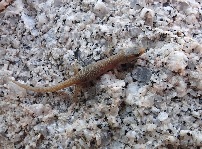Desert Night Lizard (Xantusia vigilis)
Description: The desert night lizard attains a snout-to-vent length (SVL) of 1.5 to 2.75 inches with a tail roughly the same length. The lizard's coloring is usually grey, yellow-brownish, or olive. Despite their name, night lizards are active during the day. They are known to easily change their color, from light olive (usually during the evening) to dark brown during the day. It is a good climber and usually eats termites, small insects, spiders and other arthropods.
The desert night lizard is small for a reptile, with the average adult female at 80 mm in total length and 1.3 g in weight. The average adult male Xantusia vigilis is 65mm in total length and 1.1 g in weight. Male desert night lizards are distinguishable from females as they are lighter and shorter in length. They also have a stouter and wider tail, as well as enlarged femoral pores. Most desert night lizards have 12 longitudinal rows of rectangular ventral scales with 30-50 granular dorsal scales around their mid-region. Above each eye, they have supraorbital scales (one around the nasal bone, two frontal ones, and two parietal scales). Typically, the color along their body ranges from light gray to brown. They can often be a single, uniform color, but some species have been found to have dark spots.
Habitat: The lizard lives in arid and semi-arid locales. During the day, it frequently may be found in rock crevices or under fallen plant debris. It is usually associated with varieties of yucca such as the Joshua Tree, Spanish Dagger, and Spanish Bayonet.
Range: the Southern California Eastern Sierra and the San Gabriel Mountains into Baja California, southern Nevada, southwestern Utah and extreme western areas of Arizona.
Found in these States:
AZ |
CA |
NV |
UT
Diet: X. vigilis usually eats termites, small insects, spiders and other arthropods.
Reproduction: X. vigilis typically give birth to no more than two offspring per birth. There is a laterality preference based on the specific oviduct and ovary used for ovulation; when only a single ovum is ovulated there is a pressure for the right ovary to overproduce a larger number of mature ova.
Reproduction within X. vigilis is dependent on a few factors, largely centering around climate variations, diet, and nutrition. Climatic changes heavily dictate the proceedings of gestation within X. vigilis. In damp climates this species of lizard will either prepone or postpone ovulation for drier conditions. For example, in a particularly damp spring, ovulation is typically postponed to occur in the middle of the following summer. Regardless of climate, breeding typically occurs during the spring and winter.
The ovulation period for X. vigilis lasts approximately 2 weeks at an optimal temperature range of 75 to 90 °F. Gestation typically lasts 90 days. No day versus night preference exists for birth itself, where the event of delivery lasts about 10 minutes. Desert night lizards may live for 8–10 years. Among night lizards, only a certain percentage of adult females will reproduce in a given year.
The X. vigilis placenta is well developed to allow for exchange of amino acids between mother and fetus. Half of the embryo's weight gain is suspected to happen during the brief egg gestation period, from the oviduct wall to the placenta. At birth, neonates average 22 to 23 mm in length (SVL) and weigh approximately 0.23g. X. vigilis mothers are reported to eat their fetal membranes.
Status: Listed as Least Concern in view of the probably relatively stable extent of occurrence, area of occupancy, number of subpopulations, and population size. No major threats are known.
»» Kingdom: Animalia - Animals
»» Phylum: Chordata - Chordates
»» Subphylum: Vertebrata - Vertebrates
»» Class: Reptilia - Reptiles
»» Order: Squamata - Lizards
»» Family: Xantusiidae - Night Lizards
»» Genus: Xantusia
»» Species: Xantusia vigilis - Desert Night Lizard
This article uses material from the Wikipedia article "Desert Night Lizard", which is released under the Creative Commons Attribution-Share-Alike License 3.0. Content may have been omitted from the original, but no content has been changed or extended.
|













